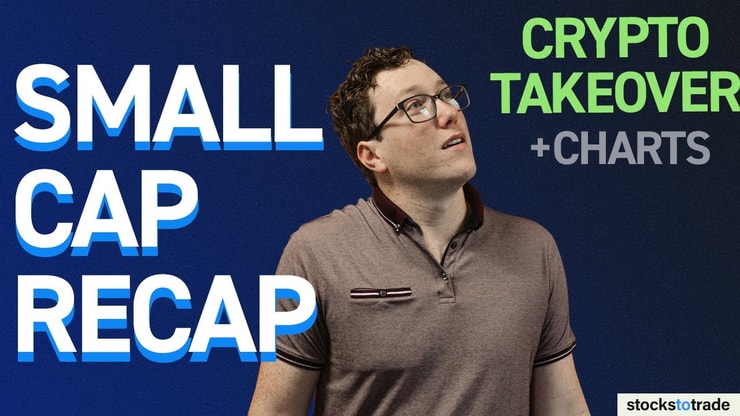Must-Know Crypto Terms: Key Takeaways
- Crypto’s too big to ignore … Here’s your starting guide for understanding this market.
- Anything that people trade affects the market, which is why you MUST know this.
- Just like stocks, crypto has its own language — read on for your crypto decoder!
Tim Bohen’s talking crypto trading PLUS an insane new strategy he’s nailed — don’t miss this event! Save your seat now.
I don’t trade crypto … but I still know these terms!
I don’t care about bragging on some crypto forum. For me, it’s about knowing more about the trading world.
With a $3 trillion market, crypto is DEFINITELY part of the trading world. Anything you learn about trading goes straight into your knowledge account. What are you waiting for?
Table of Contents
- 1 Crypto Terms You Need to Know
- 1.1 Address
- 1.2 Altcoin
- 1.3 Blockchain
- 1.4 Coin Burning
- 1.5 Consensus
- 1.6 Centralized Exchanges
- 1.7 Crypto Derivatives
- 1.8 Cryptography
- 1.9 DeFi
- 1.10 Decentralized Exchanges
- 1.11 Exit Scam
- 1.12 Fiat
- 1.13 Fork
- 1.14 Gas
- 1.15 Halving
- 1.16 Hash Rate
- 1.17 Initial Coin Offering (ICO)
- 1.18 Mining
- 1.19 Private Key/Public Key
- 1.20 Proof-of-Stake (PoS)
- 1.21 Proof-of-Work (PoW)
- 1.22 Smart Contract
- 1.23 Stablecoin
- 1.24 Staking
- 1.25 Token
- 1.26 Wallet
- 2 Crypto Slang
- 3 How Do You Trade Crypto?
- 4 Conclusion
Crypto Terms You Need to Know

2025 Millionaire Media, LLCYou can actually use what you learn here today in the real world. Pay attention.
Address
Some use this term to refer to the coordinates for a crypto wallet. This is the same as a public key. A bitcoin address can also refer to a one-time virtual location for a bitcoin transaction.
Altcoin
According to my millionaire student Matthew Monaco, altcoins are where crypto’s big trades happen.
Altcoin refers to a newer token — not bitcoin or ether. Matt calls altcoins the penny stocks of the crypto world…
Since they have small market caps, it’s easier for them to go exponential.
More Breaking News
- TeraWulf Surge: What’s Driving the Momentum?
- Hertz Stock Faces Challenges: Analysis and Overview
- PTEN Stock Plummets Amid Sector Concerns
Blockchain
Think of the blockchain like a record book. Each block equals one page.
The cool thing about blockchain is its decentralized nature. Since these blocks aren’t in one place, they’re less vulnerable to fraud.
Coin Burning
Want to make a coin more valuable? Burn some of its supply.
This is done by sending it to a wallet with no private key.
Many of the newer cryptos have realized that this is a way to shrink supply and increase demand. Some have built coin burning into their operational models.
Consensus
Consensus is the process that crypto transactions are approved under — that’s how they cut out the middleman. Most cryptos use proof-of-work (PoW) and proof-of-stake (PoS).
Centralized Exchanges

2025 Millionaire Media, LLCCentralized exchanges (CEXs) operate in much the same way as stock trading platforms. They track orders, safeguard money, and ideally provide customer support.
Crypto Derivatives
Crypto derivatives are similar to stock derivatives. Crypto futures and crypto options are two of the most popular products.
Cryptography
This is the language of crypto … and it’s the way that transactions remain secure. Basically, it’s the study of codes.
DeFi
DeFi stands for decentralized finance. This is financial tech that might just revolutionize the world and put things like banks out of business. It relies on things like smart contracts instead of brokers and exchanges.
Decentralized Exchanges
Decentralized exchanges (DEXs) are one application of DeFi. Here, two parties can do a transaction without an authority to keep things smooth…
This is the revolution that crypto fans are talking about. It can also sometimes lead to trouble.
Exit Scam
Imagine someone offering something for sale…
People trust them enough to hand over money before getting the product. And then they disappear.
This is the premise of an exit scam. Developers do an initial coin offering (ICO) — then cut and run. With crypto’s uneven regulation, there are no guarantees.
Every day I hear something shadier & shadier about #Bitcoin & #cryptocurrency so I’ll continue to say BE CAREFUL! As shady & incompetent as most penny stock companies are, crypto is 100x worse. I’m not in WhatsApp/Telegram or Twitter promoting shady wallets, those are impostors!
— Timothy Sykes (@timothysykes) June 26, 2021
Fiat
Fiat currencies are any government-issued currencies. Many crypto traders talk about fiat dismissively — but they usually pay their rent with it.
Fork
A fork is a deviation in a blockchain’s operating system. That could happen due to programming disputes, an attack, or a bug. This can lead to the kind of split that created bitcoin cash.
Gas
Ethereum transactions don’t get a free ride. Gas refers to the fee or value you pay for the computing power needed to execute contracts on the Ethereum blockchain.
Halving
Halving is the much more effective counterpart to coin burning. After a specified number of coins have been mined, the reward rate is reduced by 50%. This reduces inflation and can induce BIG volatility.
When bitcoin halved its rewards in 2020, bitcoin fans called it the ‘Halvening’ or ‘Halving.’
Hash Rate
This is the speed of mining crypto. Mining is also how transactions are validated in the crypto sphere. A healthy ecosystem has a high hash rate.
Initial Coin Offering (ICO)
I warn my students about chasing IPOs…
I get how excited everyone is about the $COIN IPO, but realize you have NO edge whatsoever trading this kind of stock & from the price action so far it looks like a typical case of over-excitement where all early buyers are underwater $30-50/share already #dontchase #Coinbase
— Timothy Sykes (@timothysykes) April 14, 2021
ICOs have an even bigger risk. The problem is that ICOs aren’t based on something of underlying value. If the market doesn’t love the coin, it isn’t worth anything.
Also, DeFi is a breeding ground for penny stock-type cons. Pumps were legion till the SEC stepped in. But there are still lots of scams going on.
Mining
Crypto creators came up with a funky process for minting new currency. It’s called mining, and it serves two purposes…
Powerful computers solve quantum-level math problems to unlock new cryptocurrency. This is the core business of a lot of crypto stocks.
They get rewarded for this. But so does the community. These computer processes serve to secure the crypto and validate transactions.
Private Key/Public Key
Your private key is your crypto password, while your public key is your crypto wallet address. They work together like a bank vault — unlocking your wallet requires the use of both keys.
Proof-of-Stake (PoS)
This is ethereum’s method of validation. In it, more coins give you more credibility. It’s more energy efficient than PoW…
Proof-of-Work (PoW)

2025 Millionaire Media, LLCThis is bitcoin’s method of validation — the crazy complex math problems that miners solve. One transaction uses more power than the average American household uses in 68 days. Not great.
Smart Contract
Smart contracts are digital contracts stored on the blockchain. They have some similarities to a physical contract. For example, before execution, they need to meet certain criteria and can’t be changed once signed.
Stablecoin
Stablecoins are tied to stable currencies like the U.S. dollar or a commodity like gold. They ensure a certain amount of stability in the crypto world. They’re also used for facilitating crypto trades.
Staking
For the PoS system to work, coin holders have to volunteer their holdings. In return, they can get compensated impressively.
Token
Another word for coin.
Wallet
A crypto wallet can be a piece of hardware or an app. The wallet manages the keys to the crypto it’s associated with on the blockchain.
Crypto Slang
Now that you’ve got the basics down, you’ve got to learn how to fit in.
Apeing
Apeing is jumping at a new token without first doing your own research.
Please don’t tweet me any promoter BS “DD”, no different than penny stock promoters or #conspiracy theorists, #cryptocurrency promoters looooove making blanket statements to lure in the gullible. I lost track of how much “amazing DD” there was on pumps like $LTNC $GGII $HMBL LOL
— Timothy Sykes (@timothysykes) December 9, 2021
ATH
ATH stands for all-time high. This is one of many stock trading terms with crypto overlap.
BTFD
Buy The F****** Dip! This is another area where crypto and stock trading overlap. It’s also one of my main strategies.
As usual, traders who do well put in a LOT of planning.
I tend to buy panic dips. That’s when the price falls rapidly. But I never try to catch a falling knife. My strategy is built on charting and watching Level 2 quotes.
It’s harder than it sounds. Watch this video for an introduction.
Diamond Hands/Weak Hands
In the Trading Challenge, we call diamond hands — staying in a trade after it goes against you — bag holding.
Pretty funny how much hate I'm getting from #Bitcoin & #dogecoin bag holders who don't realize it IS possible to make MILLIONS OF PERCENT & still lock in the profits too like one of my top https://t.co/occ8wKmlgm students @mono_trader has done. Also check out the $WSRC run today! https://t.co/tlQKGGYPMg
— Timothy Sykes (@timothysykes) June 22, 2021
Weak hands — being pressured out of a position — might also be poor trading. Don’t rely on the strength of your nerves — rely on your trading plan.
DYOR
Do your own research.
Crypto has given rise to a whole new level of lazy and it's sad, there's no shortcuts on the way to lasting financial success, you MUST study and learn how to manage your upside AND all the potential risks too
— Timothy Sykes (@timothysykes) January 16, 2018
Flippening
The Flippening is the theoretical future event where ether’s value overtakes bitcoin’s.
FOMO
Fear of missing out — FOMO — affects people in the stock trading world as well.
FUD
Fear, uncertainty, doubt. Crypto enthusiasts use this whenever some CEO or big-time investor says that crypto’s just a fad.
HODL
This popular WallStreetBets war cry comes from the world of crypto from a trader who misspelled hold. Now it’s an acronym for ‘hold on for dear life.’ Crypto and stock traders may use it when they refuse to sell. Not my approach.
Lambo

2025 Millionaire Media, LLCWhen someone asks, “When Lambo?” they want to know when a coin will shoot up high enough to buy a Lamborghini.
Moon
You’ve heard this one. When crypto shoots up, people say it’s headed “to the moon.”
Sh**coin
This is a coin with bad prospects.
Stacking Sats
Satoshi Nakomoto is the pseudonym of bitcoin’s founder — this guy is the crypto world’s version of The Wizard of Oz. He created bitcoin then vanished, leaving the project to be decentralized and collectively managed.
Satoshis are equal to .0001 Bitcoins. When a crypto trader says they’re ‘stacking sats,’ that means they’re buying bitcoin.
Whale
These are the big coin holders. What they do can influence the entire market.
How Do You Trade Crypto?

2025 Millionaire Media, LLCI don’t trade crypto. It’s too crazy for me.
I like to control my trades. With crypto, the only way to do that is by not sleeping.
I leave the crypto trading to top students like Matt Monaco and Kyle Williams. Matt has made almost $2 million trading stocks. Kyle is at $2.9 million.
They’ve figured out how to take their winning stock strategy into the world of crypto. With Crypto Rockets, they share trades, watchlists, and more.
It’s Matt and Kyle’s entire crypto strategy — in one place.
Get the most comprehensive crypto trading guidance right here.
Conclusion
If you trade anything, you need to STUDY UP!
It’s often said that 90% of stock traders lose. Despite the bitcoin billionaires, I think the number of crypto losers is even higher.
They lose for the same reason — not doing the work. Studying is the building block of a good trading career.
There’s a lot of misinformation out there. Knowledge is your shield and sword.
Is my crypto terms list thorough enough for you? What’s your favorite slang term? Let me know in the comments!











Leave a reply